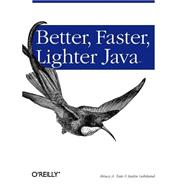
Bruce Tate is a kayaker, mountain biker, and father of two. In his spare time, he is an independent consultant in Austin, Texas. In 2001, he founded J2Life, LLC, a consulting firm that specializes in Java persistence frameworks and lightweight development methods. His customers have included FedEx, Great West Life, TheServerSide, and BEA. He speaks at conferences and Java user's groups around the nation. Before striking out on his own, Bruce spent thirteen years at IBM working on database technologies, object-oriented infrastructure and Java. He was recruited away from IBM to help start the client services practice in an Austin start up called Pervado Systems. He later served a brief stent as CTO of IronGrid, which built nimble Java performance tools. Bruce is the author of four books, including best-selling Bitter Java.
First rule of kayak: When in doubt, paddle like Hell
Working as a professional programmer, instructor, speaker and pundit since 1992, Justin Gehtland has developed real-world applications using VB, COM, .NET, Java, Perl and a slew of obscure technologies since relegated to the trash heap of technical history. His focus has historically been on "connected" applications, which of course has led him down the COM+, ASP/ASP.NET and JSP roads.
Justin is the co-author of Effective Visual Basic (Addison Wesley, 2001) and Windows Forms Programming in Visual Basic .NET (Addison Wesley, 2003). He is currently the regular Agility columnist on The Server Side .NET, and works as a consultant through his company Relevance, LLC in addition to teaching for DevelopMentor.
| Preface | ix | ||||
|
1 | (16) | |||
|
1 | (8) | |||
|
9 | (2) | |||
|
11 | (4) | |||
|
15 | (2) | |||
|
17 | (19) | |||
|
17 | (4) | |||
|
21 | (5) | |||
|
26 | (9) | |||
|
35 | (1) | |||
|
36 | (25) | |||
|
37 | (4) | |||
|
41 | (5) | |||
|
46 | (6) | |||
|
52 | (8) | |||
|
60 | (1) | |||
|
61 | (26) | |||
|
61 | (1) | |||
|
62 | (2) | |||
|
64 | (6) | |||
|
70 | (7) | |||
|
77 | (2) | |||
|
79 | (3) | |||
|
82 | (3) | |||
|
85 | (2) | |||
|
87 | (20) | |||
|
88 | (10) | |||
|
98 | (4) | |||
|
102 | (4) | |||
|
106 | (1) | |||
|
107 | (22) | |||
|
107 | (5) | |||
|
112 | (11) | |||
|
123 | (3) | |||
|
126 | (2) | |||
|
128 | (1) | |||
|
129 | (22) | |||
|
129 | (1) | |||
|
130 | (11) | |||
|
141 | (4) | |||
|
145 | (5) | |||
|
150 | (1) | |||
|
151 | (26) | |||
|
151 | (3) | |||
|
154 | (5) | |||
|
159 | (2) | |||
|
161 | (9) | |||
|
170 | (5) | |||
|
175 | (2) | |||
|
177 | (27) | |||
|
178 | (1) | |||
|
179 | (3) | |||
|
182 | (1) | |||
|
182 | (1) | |||
|
183 | (4) | |||
|
187 | (6) | |||
|
193 | (3) | |||
|
196 | (3) | |||
|
199 | (4) | |||
|
203 | (1) | |||
|
204 | (22) | |||
|
204 | (3) | |||
|
207 | (4) | |||
|
211 | (3) | |||
|
214 | (2) | |||
|
216 | (2) | |||
|
218 | (6) | |||
|
224 | (2) | |||
|
226 | (8) | |||
|
226 | (5) | |||
|
231 | (1) | |||
|
232 | (1) | |||
|
232 | (2) | |||
| Bibliography | 234 | (3) | |||
| Index | 237 |
The New copy of this book will include any supplemental materials advertised. Please check the title of the book to determine if it should include any access cards, study guides, lab manuals, CDs, etc.
The Used, Rental and eBook copies of this book are not guaranteed to include any supplemental materials. Typically, only the book itself is included. This is true even if the title states it includes any access cards, study guides, lab manuals, CDs, etc.